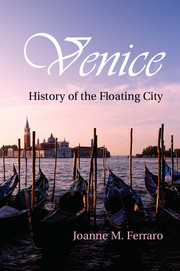Book contents
- Frontmatter
- Contents
- Plates
- Illustrations
- Maps
- Acknowledgments
- Preface
- Chronology of Historical Events
- 1 Reconstructing the Floating City
- 2 The Riches of Asia, Europe, and North Africa
- 3 A Pride of Lions
- 4 Identities and Modes of Socialization
- 5 Material Life
- 6 City of Myth
- 7 The Serenissima’s Wayward Subjects
- 8 The Baroque Stage
- 9 Epilogue
- Appendix I Approximate Population of Venice during the Republic
- Appendix II Population of the Historic Center of Venice, 1871–2010
- Glossary
- Notes
- Bibliography
- Index
- Plate Section
- References
8 - The Baroque Stage
Published online by Cambridge University Press: 05 August 2012
- Frontmatter
- Contents
- Plates
- Illustrations
- Maps
- Acknowledgments
- Preface
- Chronology of Historical Events
- 1 Reconstructing the Floating City
- 2 The Riches of Asia, Europe, and North Africa
- 3 A Pride of Lions
- 4 Identities and Modes of Socialization
- 5 Material Life
- 6 City of Myth
- 7 The Serenissima’s Wayward Subjects
- 8 The Baroque Stage
- 9 Epilogue
- Appendix I Approximate Population of Venice during the Republic
- Appendix II Population of the Historic Center of Venice, 1871–2010
- Glossary
- Notes
- Bibliography
- Index
- Plate Section
- References
Summary
Venice’s position as a European state and a global commercial force after 1630 lies in the shadow of its medieval and Renaissance glory. No longer a dominant Mediterranean power, the Republic also began to lose its status as a first-rank European state. By 1625 French, English, Dutch, and Hanseatic ships had assumed prominence in the Mediterranean. The rising cost of lumber and the difficulties in acquiring sufficient supplies of hemp made it too costly for Venice’s shipbuilders to keep up with the foreigners’ superior vessels. Moreover, the Venetians had continued to rely on antiquated navigational methods. Even Venetian merchants preferred to rent foreign-made ships rather than use the ones produced in their own shipyard. Venetian sea power also suffered because Mediterranean piracy escalated notably after 1570. Ottoman Turks, Albanians, Corsairs, Spanish, Maltese, Tuscans, Neapolitans, and Sicilians all raided Venetian ships, causing heavy losses. Uskok and Barbary pirates wore down the transport business, compelling merchants either to take less efficient overland routes or to send their cargo via foreign ships in order to avoid further losses from raiding marauders. Venetian patrician families, rich from centuries of trade, were unmotivated to take further risks. They substituted agents for themselves on the long sea expeditions that once occupied their energies.
- Type
- Chapter
- Information
- VeniceHistory of the Floating City, pp. 174 - 200Publisher: Cambridge University PressPrint publication year: 2012



